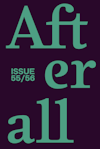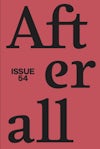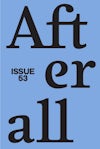
Issue 2
Spring/Summer 2000
Editors: Charles Esche, Mark Lewis, Silke Otto-Knapp.
Founding editors: Charles Esche, Mark Lewis.
Table of contents
Foreword
Contextual Essays
- Art and Social Responsibility: The Ideology of Romanticism – Alex Comfort
- It Must Be the Weather. Today’s Forecast: Again, Mainly Capitalism – Shepherd Steiner
- Afterword: Art and Theatre – Charles Esche
Artists
Julie Becker
- Julie Becker: The Invisible Is Real (Walter De Maria) – Markus Muller
- Julie Becker – Peter Wollen
Isa Genzken
- Isa Genzken – Christiane Schneider
- Isa Genzken’s Outdoor Sculpture – David Bussel
Walter De Maria
- Fade Away and Radiate – Graham Gussin
- Alone in a Crowd: The Solitude of Walter De Maria’s New York Earth Room and Broken Kilometer – Jeffrey Kastner
Peter Doig
- Rainbows and Other Ruins – Johanne Sloane
- Dots on Doig – Daniel Richter
Olafur Eliasson
- Non-Trueness as the Nature of Theatre – Andreas Spiegl
- Olafur Eliasson – Gertrud Sandqvist
Foreword
Written by Charles Esche
At a time when concern for a ‘socially engaged art practice’ seems to have come to dominate discussions about contemporary art and its audiences, Afterall number 2 serves as a kind of mild palliative…
I believe that here in America, some of us, free from the weight of European culture, are finding the answer, by completely denying that art has any concern with the problem of beauty and where to find it. The time without a legend or mythos that can be called sublime, if we refuse to admit any exaltation in pure relations, if we refuse to live in the abstract, how can we be creating a sublime art?
– Barnet Newman, The Sublime Is Now, 1948
At a time when concern for a ‘socially engaged art practice’ seems to have come to dominate discussions about contemporary art and its audiences, Afterall number 2 serves as a kind of mild palliative. This third issue covers the work of five artists whose activities, while certainly recognising the contribution of the audience, do so more as a group of perceptive individuals rather than as a constituency to be represented or served. Indeed, perception – as in the initial encounter with a work of art – is emphasised by the five artists in terms that come close to Newman’s notion (via Kant and Burke) of the sublime as unbeautiful and a measure of the inexpressible exaltation of our relationship to the phenomenal world.
Purchase
The publication is available for purchase. If you would like specific articles only, it is also available individually and to be downloaded as PDFs.
Purchase full publication
Buy via University of Chicago Press
Buy via Central Books
Purchase individual articles
Buy via University of Chicago Press



